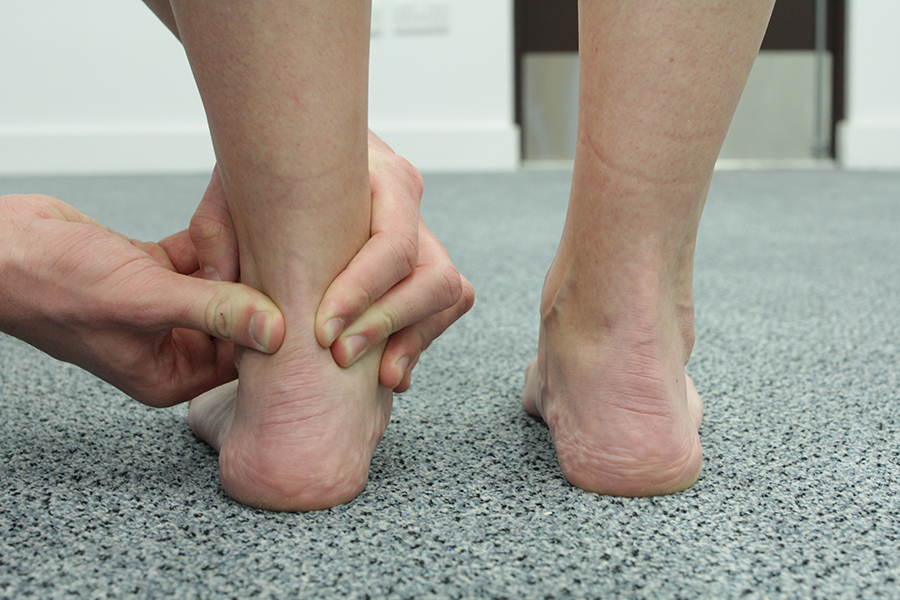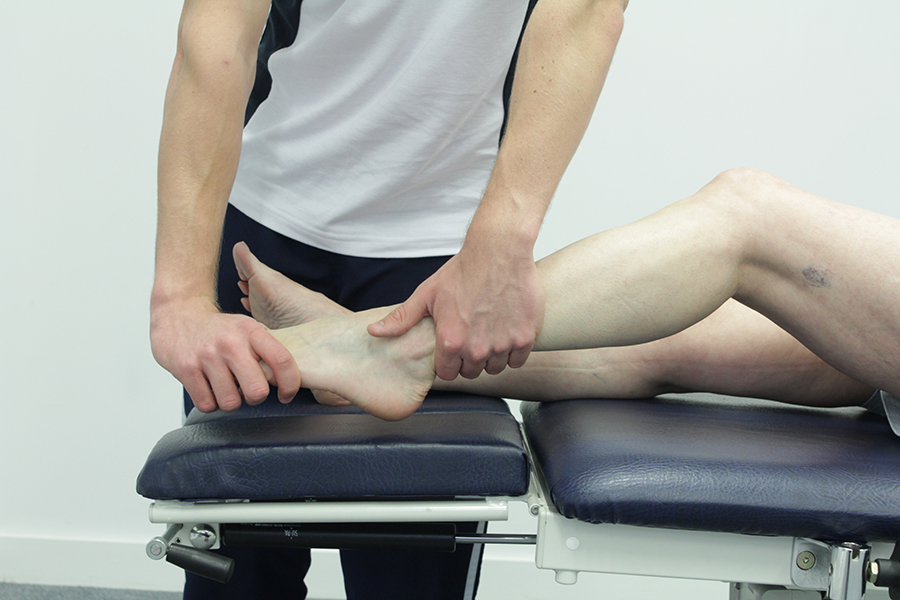Dislocation of the peroneal tendons
Peroneal tendon dislocation is when the peroneal tendons, which are positioned on the outside of the ankle, move out of position. Dislocation of the peroneal tendons typically occurs following an injury to a connective band of tissue known as the peroneal retinaculum. The peroneal retinaculum is situated just below, and in front of the outside of the ankle bone. The peroneal retinaculum is responsible for holding the peroneal tendons securely in place. Injury that stretches or tears the peroneal retinaculum results in dislocation of the peroneal tendons.
If you think you may have dislocated your peroneal tendons it is important that you visit a doctor so that a cast can be applied to the foot to hold the peroneal tendons securely in place whilst the retinaculum heals. Following casting podiatry can help you by assessing the mechanics of your leg and foot to see if poor mechanics contributed to your injury. The aim of podiatry for peroneal dislocation is to improve the overall function of the foot and prevent further injury.
Dislocation of the peroneal tendons is quite rare, but when it does occur it causes pain and altered mechanics of the foot, which affects how the foot functions and has a direct impact on gait.
The peroneal tendons come from two muscles on the outside of the leg, these muscles are responsible for pointing the foot outwards (eversion). The two peroneal tendons are held in place by a structure called the peroneal retinaculum, which is positioned on the outside of the foot just below the ankle bone. Injury to the peroneal retinaculum can cause it to stretch and/or tear, which allows the peroneal tendons to move out of position, or 'dislocate'. When the peroneal tendons dislocate it can cause damage to the tendons. When the peroneal tendons are damaged it affects the way that the tendons work, and as a result they do not function correctly.

Dislocation of the peroneal tendons is not that common, however those who ski or those who have suffered a severe ankle sprain are more at risk of the injury. Dislocation of the peroneal tendons occurs when the peroneal retinaculum (a fibrous band that holds the peroneal tendons securely in place) is torn or stretched.
Often following injury to the retinaculum there is no pain and the symptoms of peroneal dislocation appear later. The signs and symptoms of peroneal dislocation include:
Dislocation of the peroneal tendons is diagnosed at Chiropody.co.uk following an assessment and an examination of the foot and peroneal tendons. Resisted eversion of the foot will cause the tendons to further displace, which is diagnostic of peroneal tendon dislocation.
If you have dislocated your peroneal tendons podiatry can benefit you following casting, or another form of immobilisation.
The benefits of podiatric intervention following dislocation of the peroneal tendons include:

At Chiropody.co.uk treatment for dislocated peroneal tendons follows the removal of any casting. The aim of podiatric treatment for peroneal dislocation is to reduce any stiffness and/or pain that is felt after casting has been removed, as well as to improve the overall function of the foot. Reduced pain and improved foot function reduces the risk of future injury, they also improve gait and posture.
In order to establish the best course of action a thorough assessment is carried out. The assessment includes a thorough medical and social history and an examination of the foot and lower limb, in which the mechanics are assessed in order to identify any abnormal function.
Following an assessment a treatment plan will be recommended. Treatment options for peroneal tendon dislocation include:
Dislocation of the peroneal tendons typically occurs following an inversion injury or ankle sprain. When the foot is forced into an inverted position the peroneal retinaculum, which secures the peroneal tendons in place can become stretched and may even tear. If the peroneal retinaculum is stretched or torn the peroneal tendons are no longer secure, they are therefore dislocated and move out of position. When the peroneal tendons dislocate the tendons themselves can become injured, also they are unable to work efficiently as they are not in their correct position. The effects of peroneal dislocation are impaired function which can affect gait, as well as pain and discomfort on the outside of the ankle.
Podiatric intervention for peroneal dislocation is advisable following any casting or immobilising.
To book an appointment at Chiropody.co.uk please Email us at office@chiropody.co.uk or call 0330 088 4222.
If you think you may have dislocated your peroneal tendons it is important that you visit a doctor so that a cast can be applied to the foot to hold the peroneal tendons securely in place whilst the retinaculum heals. Following casting podiatry can help you by assessing the mechanics of your leg and foot to see if poor mechanics contributed to your injury. The aim of podiatry for peroneal dislocation is to improve the overall function of the foot and prevent further injury.
What is dislocation of the peroneal tendons?
Dislocation of the peroneal tendons is quite rare, but when it does occur it causes pain and altered mechanics of the foot, which affects how the foot functions and has a direct impact on gait.
The peroneal tendons come from two muscles on the outside of the leg, these muscles are responsible for pointing the foot outwards (eversion). The two peroneal tendons are held in place by a structure called the peroneal retinaculum, which is positioned on the outside of the foot just below the ankle bone. Injury to the peroneal retinaculum can cause it to stretch and/or tear, which allows the peroneal tendons to move out of position, or 'dislocate'. When the peroneal tendons dislocate it can cause damage to the tendons. When the peroneal tendons are damaged it affects the way that the tendons work, and as a result they do not function correctly.

What causes dislocation of the peroneal tendons?
Dislocation of the peroneal tendons is not that common, however those who ski or those who have suffered a severe ankle sprain are more at risk of the injury. Dislocation of the peroneal tendons occurs when the peroneal retinaculum (a fibrous band that holds the peroneal tendons securely in place) is torn or stretched.
What are the signs and symptoms of dislocation of the peroneal tendons?
Often following injury to the retinaculum there is no pain and the symptoms of peroneal dislocation appear later. The signs and symptoms of peroneal dislocation include:
- Ankle pain/discomfort on the outside of the ankle
- Ankle instability
- Disruption in the function of the foot, particularly eversion (pointing the foot outwards)
How is dislocation of the peroneal tendons diagnosed?
Dislocation of the peroneal tendons is diagnosed at Chiropody.co.uk following an assessment and an examination of the foot and peroneal tendons. Resisted eversion of the foot will cause the tendons to further displace, which is diagnostic of peroneal tendon dislocation.
Benefits of podiatry for dislocation of the peroneal tendons
If you have dislocated your peroneal tendons podiatry can benefit you following casting, or another form of immobilisation.
The benefits of podiatric intervention following dislocation of the peroneal tendons include:
- A decrease in pain
- A reduction in stiffness of the joints of the foot and ankle
- An improvement in the function of the ankle and foot
- An improvement in the strength of the ankle
- An improvement in the flexibility and range of motion at the ankle
- A reduction in the risk of future injury

What would podiatry for dislocation of the peroneal tendons involve?
At Chiropody.co.uk treatment for dislocated peroneal tendons follows the removal of any casting. The aim of podiatric treatment for peroneal dislocation is to reduce any stiffness and/or pain that is felt after casting has been removed, as well as to improve the overall function of the foot. Reduced pain and improved foot function reduces the risk of future injury, they also improve gait and posture.
In order to establish the best course of action a thorough assessment is carried out. The assessment includes a thorough medical and social history and an examination of the foot and lower limb, in which the mechanics are assessed in order to identify any abnormal function.
Following an assessment a treatment plan will be recommended. Treatment options for peroneal tendon dislocation include:
- Orthoses
- Stretching Programmes
- Strengthening programme
- Balance exercises
- Joint mobilisation
- Soft tissue mobilisation
- Footwear review
- Advice and education
Summary
Dislocation of the peroneal tendons typically occurs following an inversion injury or ankle sprain. When the foot is forced into an inverted position the peroneal retinaculum, which secures the peroneal tendons in place can become stretched and may even tear. If the peroneal retinaculum is stretched or torn the peroneal tendons are no longer secure, they are therefore dislocated and move out of position. When the peroneal tendons dislocate the tendons themselves can become injured, also they are unable to work efficiently as they are not in their correct position. The effects of peroneal dislocation are impaired function which can affect gait, as well as pain and discomfort on the outside of the ankle.
Podiatric intervention for peroneal dislocation is advisable following any casting or immobilising.
To book an appointment at Chiropody.co.uk please Email us at office@chiropody.co.uk or call 0330 088 4222.
Save 5% by booking an appointment online.

Find your nearest clinic
We have clinics located throughout the North West. We also provide a home visit service.
Find out more »

No waiting lists!
Tired of waiting for treatment? Be seen by a podiatrist today!
Find out more »

Not sure how we can help?
Speak to a podiatrist to find out how we can help. Call us on 0330 088 4222.
Find out more »
We work with:

Individuals

Organisations

Health professionals
Get in Touch!
0330 088 4222
If you would like to speak to one of our specialists then please complete this form.
We are open 7 days a week








